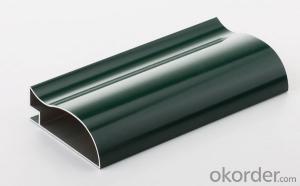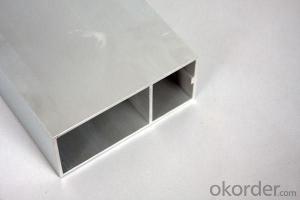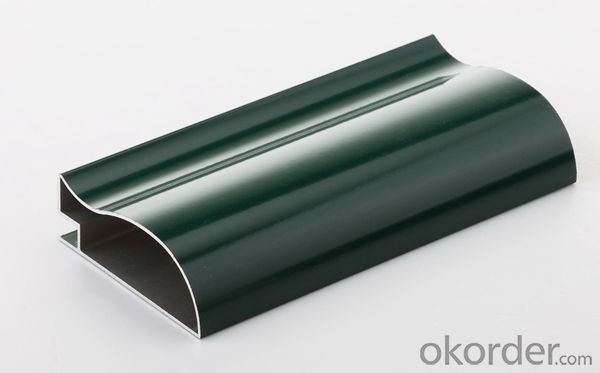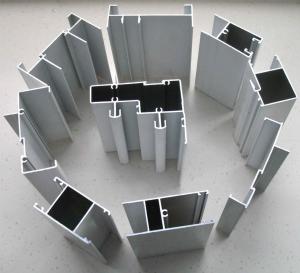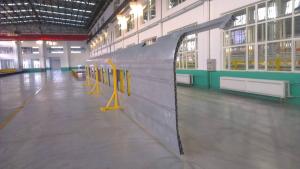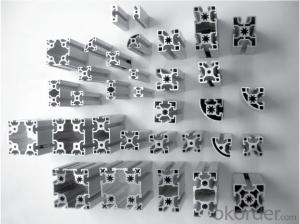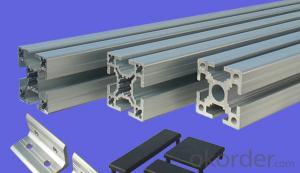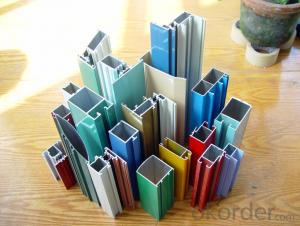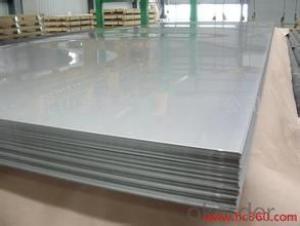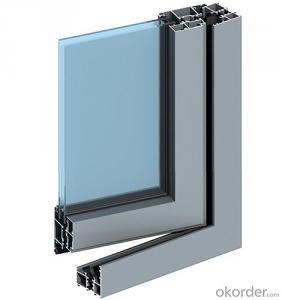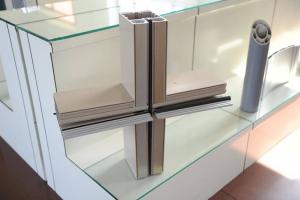Mill Finish Anodized Aluminum Profiles Products in China
- Loading Port:
- Shanghai
- Payment Terms:
- TT OR LC
- Min Order Qty:
- 1 m.t.
- Supply Capability:
- 1000 m.t./month
OKorder Service Pledge
OKorder Financial Service
You Might Also Like
Specification
1. Specification of Mill Finish Anodized Aluminum Profiles Products in China
Alloy | State | Tensile Strength δbMpa | Non-proportional Stretching Stress(δp0.2Mpa) | Stretching rate (δ%) | Pattern Thickness (mm) | HV | HW |
No Less Than | |||||||
6061 | T4/T6 | 180/265 | 110/245 | 16/8 | - | - | - |
6063 | T5/T6 | 160/205 | 110/180 | 8/8 | 0.8/- | 58/- | 8/- |
6063A | T5/T6 | 200,190/230,220 | 160,150/190,180 | 5,5/5,4 | 0.8,0.8/-,- | 65,65/-,- | 10,10/-,- |
2. Application of Mill Finish Anodized Aluminum Profiles Products in China
wall cladding, ceilings, bathrooms, kitchens and balconies, shutters, doors,windows…
3. Feature of Mill Finish Anodized Aluminum Profiles Products in China
Surface Quality :
Be free from Oil Stain, Dent, Inclusion, Scratches, Stain, Oxide Decoration, Breaks, Corrosion, Roll Marks, Dirt Streaks and other defect which will interfere with use,
Mochenical Property:
Chemical Composite and Mechanical Property
4. Certificate:
SGS and ROHS(if client request, paid by client), MTC(plant provided), Certificate of Origin(FORM A, FORM E, CO), Bureau Veritas and SGS (if client request, paid by client), CIQS certificate
5. Image of Mill Finish Anodized Aluminum Profiles Products in China
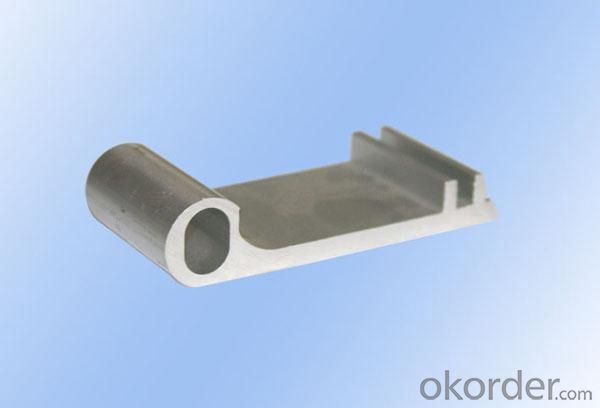
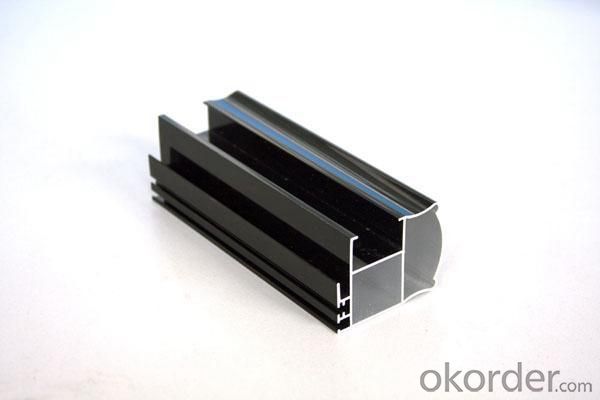
6. Package and shipping of Mill Finish Anodized Aluminum Profiles Products in China
First, plastic cloth with drying agent inside; Second, Pearl Wool; Third, wooden cases with dry agent, fumigation wooden pallets, aluminum surface could cover blue PVC film
7. FAQ
Question 1: What is your MOQ?
We accept one ton per type for an order. But the detail we could negotiate.
Question 2: What is your normal terms of payment?
We always trade with you by T/T. But we also accept the L/C as you require.
Question 3: How many kinds of the surface treatment we can choose?
You could choose different color of powder coated. Anodized of black. matte silver, nature, champagne, bronze color. Mill finished. Wooden finished and printed.etc.
Question 4: Can you supply OEM services?
We offer OEM services for 17 years.
Question 5: How many days for opening the mould?
Normally about 10 days.According to the difficulty of your drawing.
Question 6: Can i choose the package what i want?
Yes, of course. We offer various kinds of package.e.g.PE foam. Shrink film. Wrapping paper.
But we would give you professional suggestion of package.
- Q: Can aluminum profiles be used for display cases or cabinets?
- Certainly, display cases or cabinets can make great use of aluminum profiles. These profiles are renowned for their lightweight nature, durability, and sleek, contemporary aesthetic, making them a favored option for showcasing products or housing belongings. Their versatility is further enhanced by the ease with which they can be personalized and their availability in various sizes and shapes to meet specific design needs. Moreover, these profiles possess exceptional resistance to corrosion, rendering them suitable for both indoor and outdoor applications. Additionally, their remarkable thermal conductivity can prove advantageous in regulating temperatures within display cases or cabinets. All in all, aluminum profiles offer a diverse and appealing solution for constructing display cases or cabinets.
- Q: This question asks for guidelines to ensure the safe and efficient installation of aluminum profiles.
- <p>To ensure the safe and effective installation of aluminum profiles, follow these steps: 1. Use high-quality aluminum profiles that meet the required specifications. 2. Accurately measure and mark the installation locations. 3. Use appropriate tools and equipment for cutting, drilling, and fastening. 4. Ensure the surface is clean, dry, and free of debris before installation. 5. Use the correct fasteners and follow the manufacturer's recommendations for torque settings. 6. Check for proper alignment and level during installation. 7. Regularly inspect and maintain the profiles to ensure they remain secure and functional. 8. Follow all safety precautions, including wearing protective gear and using secure work platforms.</p>
- Q: Are aluminum profiles suitable for use in exterior insulation systems?
- <p>Yes, aluminum profiles can be used for exterior insulation systems. They offer high strength, durability, and resistance to weathering, making them ideal for external applications. Aluminum profiles are lightweight, easy to install, and can be used to create a robust framework for insulating materials, enhancing the energy efficiency and thermal performance of buildings.</p>
- Q: This question asks if aluminum profiles can be utilized for the purpose of exterior wall insulation.
- <p>Yes, aluminum profiles can be used for exterior wall insulation. They are often used as a component in various insulation systems due to their durability, lightweight, and resistance to corrosion. Aluminum profiles provide a structural framework that can support insulation materials like mineral wool or polystyrene boards. They also facilitate the attachment of cladding, which can enhance the building's energy efficiency and weather resistance. However, it's important to ensure proper installation and compatibility with other materials in the insulation system to achieve optimal thermal performance.</p>
- Q: Are there any differences between aluminum alloy and aluminum alloy?
- Aluminum alloy refers to the material, aluminum alloy refers to the productIt's like the difference between gold and gold
- Q: This question asks for a list of various types of fasteners that can be used with aluminum profiles specifically designed for outdoor applications.
- <p>Aluminum profiles for outdoor applications commonly use several types of fasteners to ensure secure and durable connections. These include: 1. T-nuts and T-bolts, which provide a strong and hidden connection within the profile. 2. Clamping blocks or plates, which are used for external fastening and can be easily adjusted. 3. Corner brackets, which are used to connect profiles at right angles. 4. Hinges, which allow for pivoting movements in doors or gates. 5. Screws and bolts, which are versatile and can be used in various configurations. 6. Adhesives, which can provide a strong bond in certain applications where mechanical fasteners are not suitable. 7. Rivets, which offer a permanent connection once installed. Each type of fastener is chosen based on the specific requirements of the outdoor structure, such as load-bearing needs, resistance to weather, and aesthetic considerations.</p>
- Q: Are aluminum profiles resistant to termites and insects?
- Yes, aluminum profiles are resistant to termites and insects.
- Q: What are the dimensions of standard aluminum profiles?
- The dimensions of standard aluminum profiles vary depending on the specific application and industry standards. However, there are common dimensions that are widely used in various industries. Typically, the width of standard aluminum profiles can range from a few millimeters to several hundred millimeters. The height or depth of profiles can also vary, ranging from a few millimeters to several inches. In terms of length, standard aluminum profiles are often available in standard lengths of 6 meters or 20 feet. However, they can also be custom-cut to specific lengths as per the requirements of the project. Moreover, the thickness or wall thickness of aluminum profiles can vary depending on the intended use and load-bearing capacity. Generally, aluminum profiles have a thickness ranging from 0.5 millimeters to several millimeters. It is important to note that these dimensions are not fixed and may vary depending on the manufacturer, industry standards, and specific requirements of the project. Therefore, it is recommended to consult the manufacturer or supplier to determine the exact dimensions of standard aluminum profiles for a particular application.
- Q: Can aluminum profiles be used in material handling equipment manufacturing?
- Yes, aluminum profiles can be used in material handling equipment manufacturing. Aluminum profiles are lightweight, corrosion-resistant, and have high strength-to-weight ratio, making them ideal for constructing various components of material handling equipment. These profiles can be easily customized and assembled to create frames, support structures, conveyor systems, and other parts of material handling equipment. Additionally, aluminum profiles offer flexibility in design, allowing for easy modifications or additions to the equipment as per specific requirements.
- Q: What are the specific requirements or considerations when using aluminum profiles in the construction or design of swimming pools and spas?
- <p>Yes, there are special requirements for using aluminum profiles in swimming pools and spas. These include corrosion resistance to withstand chlorinated water, which is common in pools and spas. Profiles must be made of marine-grade aluminum to prevent rust and ensure longevity. They should also be able to withstand high humidity and temperature fluctuations. Additionally, profiles need to be non-slip and easy to clean to maintain safety and hygiene. The design should also consider structural integrity to support the weight of the pool or spa structure and any associated equipment.</p>
Send your message to us
Mill Finish Anodized Aluminum Profiles Products in China
- Loading Port:
- Shanghai
- Payment Terms:
- TT OR LC
- Min Order Qty:
- 1 m.t.
- Supply Capability:
- 1000 m.t./month
OKorder Service Pledge
OKorder Financial Service
Similar products
Hot products
Hot Searches
Related keywords
